
65. A 3-g bullet is fired horizontally into a 10-kg block of wood suspended by a rope from the
ceiling. The block swings in an arc, rising 3 mm above its lowest position. The velocity of the
bullet was:
A. unknown since the heat generated in the collision was not given
B. 8.0×102m/s
C. 24.0m/s
D. 8.00 m/s
E. 2.4×104m/s
ans: B
66. A 3.0-kg and a 2.0-kg cart approach each other on a horizontal air track. They collide and
stick together. After the collision their total kinetic energy is 40 J. The speed of their center
of mass is:
A. zero
B. 2.8m/s
C. 4.0m/s
D. 5.2m/s
E. 6.3m/s
ans: C
67. Blocks A and B are moving toward each other. A has a mass of 2.0 kg and a velocity of 50 m/s,
while B has a mass of 4.0 kg and a velocity of −25 m/s. They suffer a completely inelastic
collision. The kinetic energy lost during the collision is:
A. 0
B. 1250 J
C. 3750 J
D. 5000 J
E. 5600 J
ans: C
68. For a completely inelastic two-body collision the kinetic energy retained by the objects is the
same as:
A. the total kinetic energy before the collision
B. the difference in the kinetic energies of the objects before the collision
C. 1
2Mv2
com, where Mis the total mass and vcom is the velocity of the center of mass
D. the kinetic energy of the more massive body before the collision
E. the kinetic energy of the less massive body before the collision
ans: C
69. A 75-kg man is riding in a 30-kg cart at 2.0m/s. He jumps offin such a way as to land on the
ground with no horizontal velocity. The resulting change in speed of the cart is:
A. zero
B. 2.0m/s
C. 3.0m/s
D. 5.0m/s
E. 7.0m/s
ans: D
136 Chapter 9: CENTER OF MASS AND LINEAR MOMENTUM
Simpo PDF Merge and Split Unregistered Version - http://www.simpopdf.com

70. An elastic collision is one in which:
A. momentum is not conserved but kinetic energy is conserved
B. total mass is not conserved but momentum is conserved
C. kinetic energy and momentum are both conserved
D. momentum is conserved but kinetic energy is not conserved
E. the total impulse is equal to the change in kinetic energy
ans: C
71. Object A strikes the stationary object B head-on in an elastic collision. The mass of A is fixed,
you may choose the mass of B appropriately. Then:
A. for B to have the greatest recoil speed, choose mB=mA
B. for B to have the greatest recoil momentum, choose mBmA
C. for B to have the greatest recoil kinetic energy, choose mBmA
D. for B to have the least recoil speed, choose mB=mA
E. for B to have the greatest recoil kinetic energy, choose mB=mA
ans: E
72. Block A, with a mass of 2.0 kg, moves along the xaxis with a velocity of 5.0m/s in the positive
x direction. It suffers an elastic collision with block B, initially at rest, and the blocks leave the
collision along the xaxis. If B is much more massive than A, the speed of A after the collision
is:
A. 0
B. +5.0m/s
C. −5.0m/s
D. +10 m/s
E. −10 m/s
ans: C
73. A very massive object traveling at 10 m/s strikes a very light object, initially at rest, and the
light object moves offin the direction of travel of the heavy object. If the collision is elastic,
the speed of the lighter object is:
A. 5.0m/s
B. 10 m/s
C. 15 m/s
D. 20 m/s
E. Can’t tell from the information given.
ans: D
74. Sphere A has mass mand is moving with velocity v. It makes a head-on elastic collision with
a stationary sphere B of mass 2m. After the collision their speeds (vAand vB) are:
A. 0, v/2
B. −v/3, 2v/3
C. −v,v
D. −2v/3, v/3
E. none of these
ans: B
Chapter 9: CENTER OF MASS AND LINEAR MOMENTUM 137
Simpo PDF Merge and Split Unregistered Version - http://www.simpopdf.com

75. Blocks A and B are moving toward each other along the xaxis. A has a mass of 2.0 kg and
a velocity of 50 m/s, while B has a mass of 4.0 kg and a velocity of −25 m/s. They suffer an
elastic collision and move offalong the xaxis. The kinetic energy transferred from A to B
during the collision is:
A. 0
B. 2500 J
C. 5000 J
D. 7500 J
E. 10000 J
ans: A
76. When a particle suffers a head-on elastic collision with another particle, initially at rest, the
greatest fraction of kinetic energy is transferred if:
A. the incident particle is initially traveling very fast
B. the incident particle is traveling very slowly
C. the incident particle is much more massive than the target particle
D. the incident particle is much less massive than the target particle
E. the incident and target particle have the same mass
ans: E
77. Two objects, X and Y, are held at rest on a horizontal frictionless surface and a spring is
compressed between them. The mass of X is 2/5 times the mass of Y. Immediately after the
spring is released, X has a kinetic energy of 50 J and Y has a kinetic energy of:
A. 20 J
B. 8 J
C. 310 J
D. 125 J
E. 50 J
ans: D
78. Two carts (A and B), having spring bumpers, collide as shown. Cart A has a mass of 2 kg and
is initially moving to the right. Cart B has a mass of 3 kg and is initially stationary. When the
separation between the carts is a minimum:
.
.
.
.
.
.
.
.
.
.
.
.
.
.
.
.
.
.
.
.
.
.
.
.
.
...
..
..
..
.
.
.
.
.
.
.
.
.
.
.
.
.
.
.
.
.
.
.
.
.
.
.
.
.
.
.
.
.
.
.
.
.
.
.
.
.
.
.
.
.
.
.
.
.
.
.
.
...
.
...
.
.
.
.
.
.
.
.
.
.
.
.
.
.
.
.
.
.
.
.
.
.
.
.
..
.
.
.
.
.
.
.
.
.
.
.
.
.
.
.
.
.
.
.
.
.
.
.
.
...
..
..
..
.
.
.
.
.
.
.
.
.
.
.
.
.
.
.
.
.
.
.
.
.
.
.
.
.
.
.
.
.
.
.
.
.
.
.
.
.
.
.
.
.
.
.
.
.
.
.
.
...
.
...
.
.
.
.
.
.
.
.
.
.
.
.
.
.
.
.
.
.
.
.
.
.
.
.
..
.
.
.
.
.
.
.
.
.
.
.
.
.
.
.
.
.
.
.
.
.
.
.
.
...
..
..
..
.
.
.
.
.
.
.
.
.
.
.
.
.
.
.
.
.
.
.
.
.
.
.
.
.
.
.
.
.
.
.
.
.
.
.
.
.
.
.
.
.
.
.
.
.
.
.
.
...
.
...
.
.
.
.
.
.
.
.
.
.
.
.
.
.
.
.
.
.
.
.
.
.
.
.
..
.
.
.
.
.
.
.
.
.
.
.
.
.
.
.
.
.
.
.
.
.
.
.
.
...
..
..
..
.
.
.
.
.
.
.
.
.
.
.
.
.
.
.
.
.
.
.
.
.
.
.
.
.
.
.
.
.
.
.
.
.
.
.
.
.
.
.
.
.
.
.
.
.
.
.
.
...
.
...
.
.
.
.
.
.
.
.
.
.
.
.
.
.
.
.
.
.
.
.
.
.
.
.
.
A
...........................................................................
.
.
..
.
.
.
.
.
.
.
.
.
.
.
.
.
.
.
...
.
.
.
.
.
.
.
.
.
.
.
.
.
.
.
.
.
.
.
.
B
.
.
.
.
.
.
.
.
.
.
.
.
.
.
.
.
.
.
.
.
.
.
..
.
.
.
.
.
.
.
.
.
.
.
.
.
.
.
.
.
.
.
.
.
..
.
.
.
.
.
.
.
.
.
.
.
.
.
.
.
.
.
.
.
.
.
.
.
..
....
.
.
.
.
.
.
.
.
.
.
.
.
.
.
.
.
.
.
.
.
.
.
.
.
.
.
.
.
.
.
.
.
.
.
.
.
.
.
.
.
.
.
.
.
.
.
.
..
.
.
.
.
.
.
.
.
.
.
.
.
.
.
.
.
.
.
.
.
.
..
.
.
.
.
.
.
.
.
.
.
.
.
.
.
.
.
.
.
.
.
.
.
.
..
....
.
.
.
.
.
.
.
.
.
.
.
.
.
.
.
.
.
.
.
.
.
.
.
.
.
.
.
.
.
.
.
.
.
.
.
.
.
.
.
.
.
.
.
.
.
.
.
..
.
.
.
.
.
.
.
.
.
.
.
.
.
.
.
.
.
.
.
.
.
..
.
.
.
.
.
.
.
.
.
.
.
.
.
.
.
.
.
.
.
.
.
.
.
..
....
.
.
.
.
.
.
.
.
.
.
.
.
.
.
.
.
.
.
.
.
.
.
.
.
.
.
.
.
.
.
.
.
.
.
.
.
.
.
.
.
.
.
.
.
.
.
.
..
.
.
.
.
.
.
.
.
.
.
.
.
.
.
.
.
.
.
.
.
.
..
.
.
.
.
.
.
.
.
.
.
.
.
.
.
.
.
.
.
.
.
.
.
.
..
....
.
.
.
.
.
.
.
.
.
.
.
.
.
.
.
.
.
.
.
.
.
.
.
.
.
.
.
.
.
.
.
.
.
.
.
.
.
.
.
.
.
.
.
.
.
.
.
..
.
.
.
.
.
.
.
.
.
.
.
.
.
.
.
.
.
.
.
.
.
..
.
.
.
.
.
.
.
.
.
.
.
.
.
.
.
.
.
.
.
.
.
.
.
..
....
.
.
.
.
.
.
.
.
.
.
.
.
.
.
.
.
.
.
.
.
.
.
.
.
.
.
.
.
.
.
.
.
.
.
.
.
.
.
.
.
.
.
.
.
.
.
.
..
.
.
.
.
.
.
.
.
.
.
.
.
.
.
.
.
.
.
.
.
.
..
.
.
.
.
.
.
.
.
.
.
.
.
.
.
.
.
.
.
.
.
.
.
.
..
....
.
.
.
.
.
.
.
.
.
.
.
.
.
.
.
.
.
.
.
.
.
.
.
.
.
.
.
.
.
.
.
.
.
.
.
.
.
.
.
.
.
.
.
.
.
.
.
..
.
.
.
.
.
.
.
.
.
.
.
.
.
.
.
.
.
.
.
.
.
..
.
.
.
.
.
.
.
.
.
.
.
.
.
.
.
.
.
.
.
.
.
.
.
..
....
.
.
.
.
.
.
.
.
.
.
.
.
.
.
.
.
.
.
.
.
.
.
.
.
.
.
.
.
.
.
.
.
.
.
.
.
.
.
.
.
.
.
.
.
.
.
.
..
.
.
.
.
.
.
.
.
.
.
.
.
.
.
.
.
.
.
.
.
.
..
.
.
.
.
.
.
.
.
.
.
.
.
.
.
.
.
.
.
.
.
.
.
.
..
....
.
.
.
.
.
.
.
.
.
.
.
.
.
.
.
.
.
.
.
.
.
.
.
.
.
.
.
.
.
.
.
.
.
.
.
.
.
.
..
.
.
.
.
.
.
.
.
.
.
.
.
..
.
.
.
.
.
.
.
.
.
.
.
.
.
.
.
.
.
.
.
.
.
..
.
.
.
.
.
.
.
.
.
.
.
.
.
.
.
.
.
.
.
.
.
..
.
.
.
.
.
.
.
.
.
.
.
.
.
.
.
.
.
.
.
.
.
.
.
..
....
.
.
.
.
.
.
.
.
.
.
.
.
.
.
.
.
.
.
.
.
.
.
.
.
.
.
.
.
.
.
.
.
.
.
.
.
.
.
.
.
.
.
.
.
.
.
.
..
.
.
.
.
.
.
.
.
.
.
.
.
.
.
.
.
.
.
.
.
.
..
.
.
.
.
.
.
.
.
.
.
.
.
.
.
.
.
.
.
.
.
.
.
.
..
....
.
.
.
.
.
.
.
.
.
.
.
.
.
.
.
.
.
.
.
.
.
.
.
.
.
.
.
.
.
.
.
.
.
.
.
.
.
.
.
.
.
.
.
.
.
.
.
..
.
.
.
.
.
.
.
.
.
.
.
.
.
.
.
.
.
.
.
.
.
..
.
.
.
.
.
.
.
.
.
.
.
.
.
.
.
.
.
.
.
.
.
.
.
..
....
.
.
.
.
.
.
.
.
.
.
.
.
.
.
.
.
.
.
.
.
.
.
.
.
.
.
.
.
.
.
.
.
.
.
.
.
.
.
.
.
.
.
.
.
.
.
.
..
.
.
.
.
.
.
.
.
.
.
.
.
.
.
.
.
.
.
.
.
.
..
.
.
.
.
.
.
.
.
.
.
.
.
.
.
.
.
.
.
.
.
.
.
.
..
....
.
.
.
.
.
.
.
.
.
.
.
.
.
.
.
.
.
.
.
.
.
.
.
.
.
.
.
.
.
.
.
.
.
.
.
.
.
.
.
.
.
.
.
.
.
.
.
..
.
.
.
.
.
.
.
.
.
.
.
.
.
.
.
.
.
.
.
.
.
..
.
.
.
.
.
.
.
.
.
.
.
.
.
.
.
.
.
.
.
.
.
.
.
..
....
.
.
.
.
.
.
.
.
.
.
.
.
.
.
.
.
.
.
.
.
.
.
.
.
.
.
.
.
.
.
.
.
.
.
.
.
.
.
.
.
.
.
.
.
.
.
.
..
.
.
.
.
.
.
.
.
.
.
.
.
.
.
.
.
.
.
.
.
.
..
.
.
.
.
.
.
.
.
.
.
.
.
.
.
.
.
.
.
.
.
.
.
.
..
....
.
.
.
.
.
.
.
.
.
.
.
.
.
.
.
.
.
.
.
.
.
.
.
.
.
.
.
.
.
.
.
.
.
.
.
.
.
.
.
.
.
.
.
.
.
.
.
..
.
.
.
.
.
.
.
.
.
.
.
.
.
.
.
.
.
.
.
.
.
..
.
.
.
.
.
.
.
.
.
.
.
.
.
.
.
.
.
.
.
.
.
.
.
..
....
.
.
.
.
.
.
.
.
.
.
.
.
.
.
.
.
.
.
.
.
.
.
.
.
.
.
.
.
.
.
.
.
.
.
.
.
.
.
.
.
.
.
.
.
.
.
.
..
.
.
.
.
.
.
.
.
.
.
.
.
.
.
.
.
.
.
.
.
.
..
.
.
.
.
.
.
.
.
.
.
.
.
.
.
.
.
.
.
.
.
.
.
.
..
....
.
.
.
.
.
.
.
.
.
.
.
.
.
.
.
.
.
.
.
.
.
.
.
.
.
.
.
.
.
.
.
.
.
.
.
.
.
.
..
.
.
.
.
.
.
.
.
.
.
.
.
.
A. cart B is still at rest
B. cart A has come to rest
C. the carts have the same momentum
D. the carts have the same kinetic energy
E. the kinetic energy of the system is at a minimum
ans: E
138 Chapter 9: CENTER OF MASS AND LINEAR MOMENTUM
Simpo PDF Merge and Split Unregistered Version - http://www.simpopdf.com

79. Two identical carts travel at 1 m/s in opposite directions on a common horizontal surface. They
collide head-on and are reported to rebound, each with a speed of 2 m/s. Then:
A. momentum was not conserved; therefore, the report must be false
B. if some other form of energy were changed to kinetic during the collision, the report could
be true
C. if the collision were elastic, the report could be true
D. if friction were present, the report could be true
E. if the duration of the collision were long enough, the report could be true
ans: B
80. A block moves at 5.0m/s in the positive xdirection and hits an identical block, initially at
rest. A small amount of gunpowder had been placed on one of the blocks. The explosion does
not harm the blocks but it doubles their total kinetic energy. After the explosion the blocks
move along the xaxis and the incident block has a speed in of:
A. 1.8m/s
B. 5.0m/s
C. 6.8m/s
D. 7.1m/s
E. 11.8m/s
ans: A
81. A stream of gas consists of n molecules. Each molecule has mass mand speed v. The stream
is reflected elastically from a rigid surface as shown. The magnitude of the change in the total
momentum of the stream is:
•
•
•
•
•
•
•
•
•
•
••
•
••
•
•
•
•
•
•
•
•
•
•
•
•
•
•
•
•
•
•
•
•
••
••
•
•
•
•
•
•
•
•
•
•
•
•
•
•
•
•
•••
•
•
•
•
•
•
•
•
•
•
•
•
•
•••
•
•
•
•
•
•
•
•
•
•
•
•
•
•
•
•
•
•
•
•
•
•
•
•
•
•
•
•
•
•
•
•
•
••
•
••
•
•
•
•
•
•
•
•
•
•
•
•
•
•
•
•
•
•
•
•
••
••
•
•
•
•
•
•
•
•
•
•
•
•
•
•
•
•
•••
•
•
•
•
•
•
•
•
•
•
•
•
•
•••
•
•
•
•
•
•
•
•
•
•
•
•
•
•
•
•
•
•
•
•
•
•
•
•
•
•
•
•
•
•
•
•
•
••
•
••
•
•
•
•
•
•
•
•
•
•
•
•
•
•
•
•
•
•
•
•
••
••
•
•
•
•
•
•
•
•
•
•
•
•
•
•
•
•
•••
•
•
•
•
•
•
•
•
•
•
•
•
•
•••
•
•
•
•
•
•
•
•
•
•
•
•
•
•
•
•
•
•
•
•
•
•
•
•
•
•
•
•
•
•
•
•
•
••
•
••
•
•
•
•
•
•
•
•
•
•
•
•
•
•
•
•
•
•
•
•
••
••
•
•
•
•
•
•
•
•
•
•
•
•
•
•
•
•
•••
•
•
•
•
•
•
•
•
•
•
•
•
•
•••
•
•
•
•
•
•
•
•
•
•
•
•
•
•
•
•
•
•
•
•
•
•
•
•
•
•
•
•
•
•
•
•
•
•
•••
•
•
•
•
•
•
•
•
•
•
•
•
•
•
•
•
•
•
•
•
•
••
••
•
•
•
•
•
•
•
•
•
•
•
•
•
•
•
•
•
•
•
•
•
•
•
•
•
•
•
•
•
•
•
•
•••
•
•
•
•
•
•
•
•
•
•••
•
•
•
•
•
•
•
•
•
•
•
•
•
•
•
•
•
•
•
•
•
••
•
••
•
•
•
•
•
•
•
•
•
•
•
•
•
•
•
•
•
•
•
•
••
••
•
•
•
•
•
•
•
•
•
•
•
•
•
•
•
•
•••
•
•
•
•
•
•
•
•
•
•
•
•
•
•••
•
•
•
•
•
•
•
•
•
•
•
•
•
•
•
•
•
•
•
•
•
•
•
•
•
•
•
•
•
•
•
•
•
••
•
••
•
•
•
•
•
•
•
•
•
•
•
•
•
•
•
•
•
•
•
•
••
••
•
•
•
•
•
•
•
•
•
•
•
•
•
•
•
•
•••
•
•
•
•
•
•
•
•
•
•
•
•
•
•••
•
•
•
•
•
•
•
•
•
•
•
•
•
•
•
•
•
•
•
•
•
•
•
•
•
•
•
•
•
•
•
•
•
••
•
••
•
•
•
•
•
•
•
•
•
•
•
•
•
•
•
•
•
•
•
•
••
••
•
•
•
•
•
•
•
•
•
•
•
•
•
•
•
•
•••
•
•
•
•
•
•
•
•
•
•
•
•
•
•••
•
•
•
•
•
•
•
•
•
•
•
•
•
•
•
•
•
•
•
•
•
•
•
•
•
•
•
•
•
•
•
•
•
••
•
••
•
•
•
•
•
•
•
•
•
•
•
•
•
•
•
•
•
•
•
•
••
••
•
•
•
•
•
•
•
•
•
•
•
•
•
•
•
•
•••
•
•
•
•
•
•
•
•
•
•
•
•
•
•••
•
•
•
•
•
•
•
•
•
•
•
•
•
•
•
•
•
•
•
•
•
•
•
.
.
.
.
.
.
.
.
.
.
.
.
.
.
.
.
.
.
.
.
.
.
.
.
.
.
.
.
.
.
.
.
.
.
.
.
.
.
.
.
.
.
.
.
.
.
.
.
.
.
..
.
.
.
.
..
.
..
..
...
....... .
.
.
.
.
.
.
.
.
.
.
.
.
.
.
.
.
.
.
.
.
.
v.
.
.
.
.
.
.
.
.
.
.
.
.
.
.
.
.
.
.
.
.
.
.
.
.
.
.
.
.
.
.
.
.
.
.
.
.
.
.
.
.
.
.
.
.
.
.
.
.
.
..
.
.
.
.
.
.
.
.
.
.
.
.
.
.
.
.
.
.
.
.
.
.
.
.
.
..
.
.
..
..
....
......
v
.
.
.
.
.
.
.
.
.
.
.
.
.
.
.
.
.
.
.
.
.
.
.
.
.
.
.30◦
.
.
.
.
.
.
.
.
.
.
.
.
.
.
.
.
.
.
.
.
.
.
.
.
.
.
.
30◦
.
.
.
.
.
.
.
.
.
.
.
.
.
.
.
.
.
.
.
.
.
.
.
.
.
.
.
.
.
.
.
.
.
.
.
.
.
.
.
.
.
.
.
.
.
.
.
.
.
.
.
.
.
.
.
.
.
.
.
.
.
.
.
.
.
.
.
.
.
.
.
.
.
.
.
.
.
.
.
.
.
.
.
.
.
.
.
.
.
.
.
.
.
.
.
.
.
.
.
.
.
.
.
.
.
.
.
.
.
.
.
.
.
.
.
.
.
.
.
.
.
.
.
.
.
.
.
.
.
.
.
.
.
.
.
.
.
.
.
.
.
.
.
.
.
.
.
.
.
.
.
.
.
.
.
.
.
.
.
.
.
.
.
.
.
.
.
.
.
.
.
.
.
.
.
.
.
.
.
.
.
.
.
.
.
.
.
.
.
.
.
.
.
.
.
.
.
.
.
.
.
.
.
.
.
.
.
.
.
.
.
.
.
.
.
.
.
.
.
.
.
.
.
.
.
.
.
.
.
.
.
.
.
.
.
.
.
.
.
.
.
.
.
.
.
.
.
.
.
.
.
.
.
.
.
.
.
.
.
.
.
.
.
.
.
.
.
.
.
.
.
.
.
.
.
.
.
.
.
.
.
.
.
.
.
.
.
.
.
.
.
.
.
.
.
.
.
.
.
.
.
.
.
.
.
.
.
.
.
.
.
.
.
.
.
.
.
.
.
.
.
.
.
.
.
.
.
.
.
.
.
.
.
.
.
.
.
.
.
.
.
.
.
.
.
.
.
.
.
.
.
.
.
.
.
.
.
.
.
.
.
.
.
.
.
.
.
.
.
.
.
.
.
.
.
.
.
.
.
.
.
.
.
.
.
.
.
.
.
.
.
.
.
.
.
.
.
.
.
.
.
.
.
.
.
.
.
.
.
.
.
.
.
.
.
.
.
.
.
.
.
.
.
.
.
.
.
.
.
.
.
.
.
.
.
.
.
.
.
.
.
.
.
.
.
.
.
.
.
.
.
.
.
.
.
.
.
.
.
.
.
.
.
.
.
.
.
.
.
.
.
.
.
.
.
.
.
.
.
.
.
.
.
.
.
.
.
.
.
.
.
.
.
.
.
.
.
.
.
.
.
.
.
.
.
.
.
.
.
.
.
.
.
.
.
.
.
.
.
.
.
.
.
.
.
.
.
.
.
.
.
.
.
.
.
.
.
.
.
.
.
.
.
.
.
.
.
.
.
.
.
.
.
.
.
.
.
.
.
.
.
.
.
.
.
.
.
.
.
.
.
.
.
.
.
.
.
.
.
.
.
.
.
.
.
A. 2mnv
B. 2mnv sin 30◦
C. mnv sin 30◦
D. mnv cos 30◦
E. mnv
ans: B
Chapter 9: CENTER OF MASS AND LINEAR MOMENTUM 139
Simpo PDF Merge and Split Unregistered Version - http://www.simpopdf.com

Chapter 10: ROTATION
1. A radian is about:
A. 25◦
B. 37◦
C. 45◦
D. 57◦
E. 90◦
ans: D
2. One revolution is the same as:
A. 1 rad
B. 57 rad
C. π/2 rad
D. πrad
E. 2πrad
ans: E
3. One revolution per minute is about:
A. 0.0524 rad/s
B. 0.105 rad/s
C. 0.95 rad/s
D. 1.57 rad/s
E. 6.28 rad/s
ans: B
4. If a wheel turns with constant angular speed then:
A. each point on its rim moves with constant velocity
B. each point on its rim moves with constant acceleration
C. the wheel turns through equal angles in equal times
D. the angle through which the wheel turns in each second increases as time goes on
E. the angle through which the wheel turns in each second decreases as time goes on
ans: C
5. If a wheel is turning at 3.0 rad/s, the time it takes to complete one revolution is about:
A. 0.33 s
B. 0.67 s
C. 1.0s
D. 1.3s
E. 2.1s
ans: E
140 Chapter 10: ROTATION
Simpo PDF Merge and Split Unregistered Version - http://www.simpopdf.com


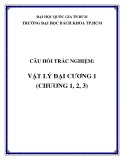
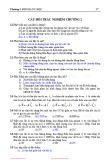
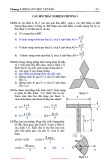

![Câu hỏi trắc nghiệm Cơ kỹ thuật [chuẩn nhất]](https://cdn.tailieu.vn/images/document/thumbnail/2014/20141226/gonvo_93/135x160/4731419585192.jpg)

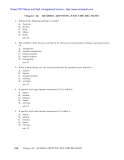
![Tuyển tập ngân hàng đề kiểm tra Vật lý (Physics Test Bank) chọn lọc [năm]](https://cdn.tailieu.vn/images/document/thumbnail/2012/20120227/kata_3/135x160/physics_test_bank_split_43_8303.jpg)
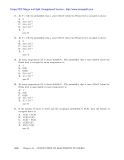








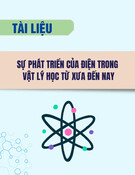
![Bộ câu hỏi lý thuyết Vật lý đại cương 2 [chuẩn nhất/mới nhất]](https://cdn.tailieu.vn/images/document/thumbnail/2025/20251003/kimphuong1001/135x160/74511759476041.jpg)
![Bài giảng Vật lý đại cương Chương 4 Học viện Kỹ thuật mật mã [Chuẩn SEO]](https://cdn.tailieu.vn/images/document/thumbnail/2025/20250925/kimphuong1001/135x160/46461758790667.jpg)




